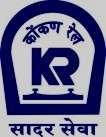Konkan Railway Corporation
Konkan Railway Corporation Limited (KRCL) is a Union Government Company headquartered at CBD Belapur in Navi Mumbai that operates Konkan Railway. The company started its full operations of trains on 26 January 1998.The first passenger train which ran on Konkan railway tracks on 20 March 1993 between Udupi and Mangalore.[1] Konkan Railway Corporation is at the forefront of research and development of new technologies and concepts for Indian railways. During its initial years of operations in the mountainous Konkan region, a spate of accidents prompted Konkan Railway to investigate new technologies. The anti-collision devices, the Sky Bus and RORO are a few of the innovations from Konkan Railways.
 | |
| Public limited | |
| Industry | Railways |
| Founded | 19 July 1990 |
| Headquarters | Navi Mumbai |
Area served | Maharashtra, Goa and Karnataka |
Key people | E. Sreedharan |
| Parent | Indian Railways |
| Website | KonkanRailway.com |

RORO

RORO means Roll-on/roll-off, where loaded trucks are directly carried by railway wagons to their destination. The first ever RO-RO service in India was run by Konkan Railway. Konkan Railways passes through tough terrains of India. There is NH-66 passing through same route. Truck drivers find it extremely difficult to drive loaded trucks through ghats, undulating surfaces, narrow roads and poor road and weather conditions. The KRC came with concept of RORO, where loaded trucks are moved on wagons and are travelled by train. This has helped in saving of fuels, decrease in wear and tear of lorries (trucks), relief to drivers of driving in extreme conditions, can reach faster to destination. This also helps in decongestion of roads and lowering of pollution. This concept has been beneficial for both truck operators and KRCL.
See also
References
- "Archived copy". Archived from the original on 1 November 2012. Retrieved 2 December 2012.CS1 maint: archived copy as title (link)